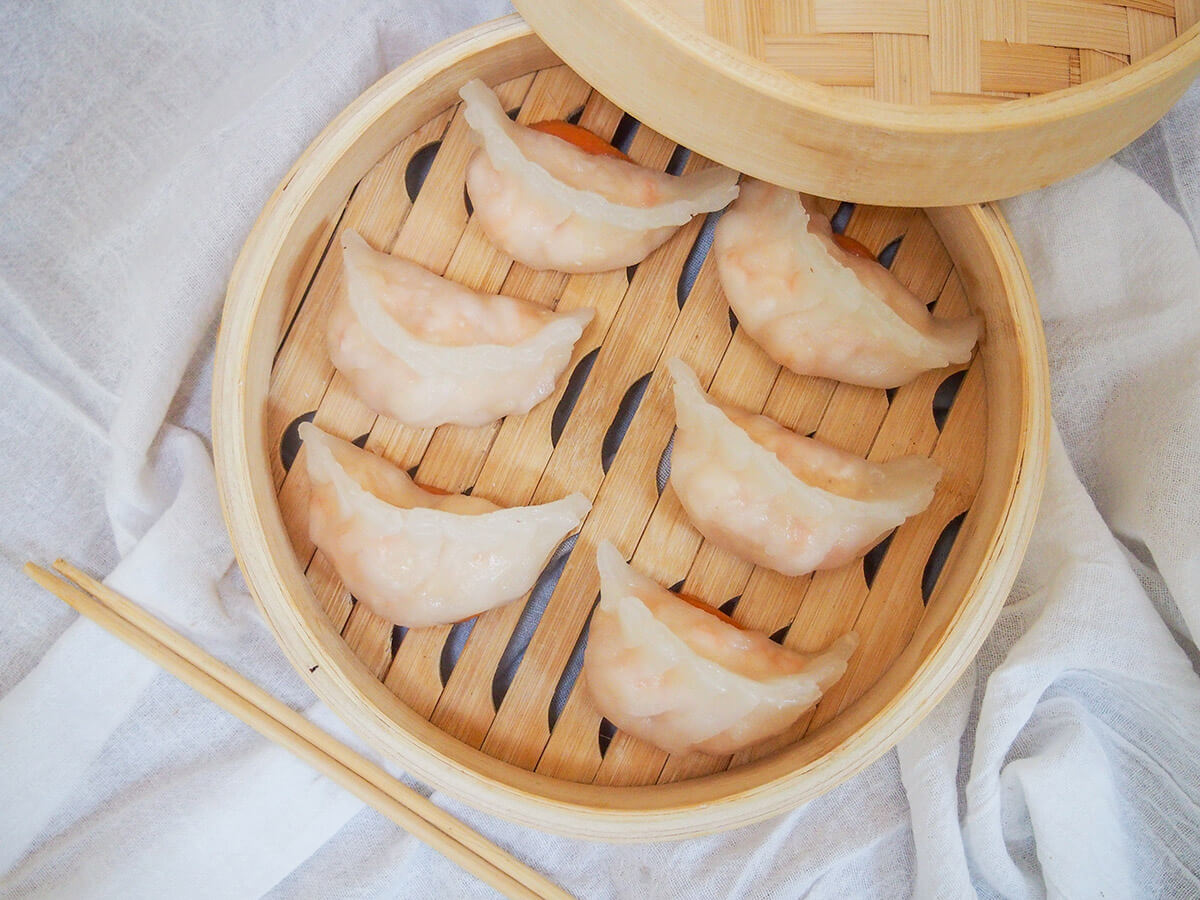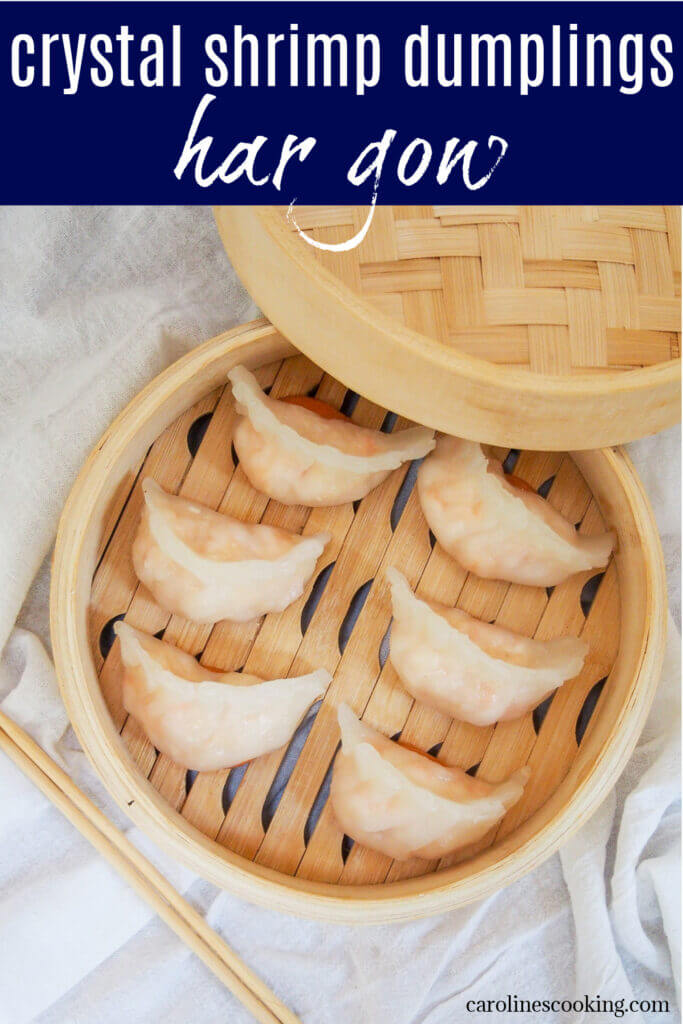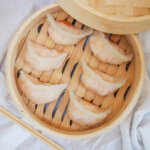Har gow are a classic Cantonese dim sum, often called crystal shrimp dumplings due to their slightly translucent wrapper. The filling is simple and lightly seasoned as it's all about the juicy shrimp. They may seem fiddly at first, but with a little practice, you'll be enjoying pretty and delicious dumplings at home.

This post may contain affiliate links, where we earn from qualifying purchases. See more details in the policy page.
When we went to Hong Kong, one of the first things on my list to hunt down food-wise was dim sum. While I've enjoyed some great dim sum elsewhere, Hong Kong is well known for it and the experiences we had did not disappoint. These lovely dumplings are a classic feature on the dumpling trolleys.
What are dim sum?
Dim sum is primarily associated with Cantonese cuisine. It is a practice that evolved from giving snacks alongside tea, traditionally for breakfast or brunch. During the 10th century, Guangzhou (the main city in Guangdong province, formerly Canton) saw an increase in commercial travel. Tea houses served "yum cha" ("drink tea") with small portions of food.
Yum cha had two concepts. The first was "yat jung leung gin" meaning "one cup two pieces" ie traditionally you would be given two small bites with your cup of tea. The other is "dim sum" meaning "touching heart", the idea being that the food touches your heart/gives you a taste rather than fills you up.

Dim sum grew in popularity in the 19th century, and the range of dishes that you might find served grew. The idea spread beyond Guangzhou, and beyond brunch. You'll find them all over the world, with both classic and fusion dishes, and at all times of the day.
Even as the idea has evolved, dumplings are still a central part of dim sum, whether it's these lovely shrimp dumplings or other styles like like pork and cabbage dumplings, shrimp shumai and pork and chive dumplings or steamed buns. Soups and sides like turnip cake and rice rolls are also common features.
What are har gow made of?
Har gow literally means "shrimp dumpling" and they were created at a teahouse in a small village in Guangzhou in Southern China. There was a stream near the teahouse where the chef caught shrimp that became the base for the dumpling fillings.
The original har gow recipes used mainly shrimp with some bamboo shoots and pork fat. Here I use shrimp, bamboo shoots and simple seasonings of ginger and sesame oil. I use oil rather than pork fat as the binding fat, as is more common in modern versions.
These days while shrimp har gow are still the most common, you can also get variations with different fillings like pork, chicken or vegetarian versions combining tofu and vegetables.

Some say har gow are the measure of how good a dim sum restaurant is. The dumpling wrapper should be delicate but not break when touched with a chopstick and there should be plenty of pleats. They should be plump and well filled.
While they can take a little practice to make at home, they are still definitely doable, and well worth trying.
What is special about har gow wrappers?
Most dumpling wrappers are made of wheat flour and water, but har gow are different. They instead use wheat starch as the base, usually combined with corn starch (corn flour), tapioca starch or potato starch to help make the dough a little more flexible.
Wheat starch is made from wheat, but goes through extra processing that largely removes the protein and fiber. It usually still has a very small amount gluten left so unless your packet specifically says it is gluten free, it may not be. This extra processing makes it much more like corn starch than flour to work with. You may need to look in an Asian store or online to find wheat starch.
One important step is that you need to use boiling water to make the dough, otherwise the dumpling skin can crack as you work with it. As in really hot, just boiled. Getting the dough right is probably the trickiest thing about these dumplings and can take a little practice, but hopefully the tips below help.

Tips for making har gow
The two main areas that can make har gow tricky are making the dough, and forming the dumplings. For the dough, as mentioned above, one of the key things is using boiling water - not just hot - and using it quickly. In terms of forming, it's mainly practice and while they may be a little uneven at first, you will soon get more in the flow and it will become easier.
Other tips to make the process smoother:
- Prepare your steamer and pot of boiling water before you make the dumplings so that it is ready. Ideally, you want a bamboo steamer for this, but other steamers can work if you can keep the dumplings separate.
- If you have steamer liners, use those, or else you can use thin slices of carrot to put each dumpling on to stop them sticking to the paper.
- Use raw shrimp as the filling cooks when you steam the dumplings. If you use ready-cooked shrimp, it may become tough as it can over-cook.
- Try to use the dumpling dough while it is still warm, as it will be easier to work with. Start by dividing the dough into equal pieces and roll each into a ball.
- Keep the dough you are not working with covered with a damp cloth to avoid them drying out. Then roll each ball into a circle.
- You may find it helpful to roll out the dough on a silicone mat to make it easier to un-stick and pick up. If your dough is dryer, it's typically best to use the side of an oiled cleaver to press the dumpling dough into a thin circle. If your dough is on the softer side, using a wheat-starch floured surface and rolling pin can work better.

Making the filling and wrappers
Once you have your steamer etc ready, first make the filling. Then, set it aside to chill while you make the dumpling dough. Some prefer a smoother filling, with the shrimp chopped finely. Alternatively, you can leave them more textured. Some go for a mix with part chopped alongside whole, small shrimp. It's really whatever your preference is.
For the dumpling dough, mix the starches, add the boiling water and mix to bring everything together. Since it will be hot, use chopsticks or a spatula to help. Then, work in the oil, which you can probably do by hand as it will have cooled a little.
The dough should be soft and malleable, but not sticky. While I have suggested an amount of water, you often have to work by feel as wheat starch can vary in how much water you need. If it cracks easily when you roll it out, it probably needs more water. If it is sticky, it probably needs more starch.
Folding the dumplings
There are a few ways to fold dumplings (see my lamb dumplings for some other ways) but har gow are typically made by forming pleats on one side so that the top of the pleats form a curved crescent along the top edge.

To form the classic folds, you place a spoonful of filling in the middle of the circle then fold up two opposite sides of the wrapper. Pinch to join on the one end. Then, make little pleats on the one side from where you pinched it together towards the other open end. The pleats should all face the same direction, and press them against the other dumpling side to seal as you go.
As you make one dumpling, place it in the steamer and make the next. Make sure they have some space between. Once you've filled your bamboo steamer, place over the pot of boiling water and cook. They will only take a few minutes. You'll know they are ready when the skin becomes near translucent and you can see the pink of the cooked shrimp through the wrapper.
Har gow are such classic dim sum shrimp dumplings, that are great to enjoy alongside other dumplings, soups and sides for dim sum at home. Or, simply enjoy as a snack. They'd be great as part of a Lunar New Year celebration, or really any excuse. So give them a go and enjoy the tasty shrimp parcels soon.

Try these other dishes for a lunar new year celebration:
- Hong shao rou (red braised pork belly - easy to make and wonderfully sticky, rick and delicious)
- Yee sang (Singapore/Malaysian Chinese in origin, this salad is light and delicious)
- San choy bow (lettuce wraps with a simple, tasty pork filling)
- Plus get more Chinese recipes in the archives.
Har gow (crystal shrimp dumplings)
Ingredients
For filling -
- 6 oz raw shrimp
- 3 tablespoon bamboo shoots
- ½ teaspoon minced ginger
- ½ teaspoon sugar
- ¼ teaspoon salt
- ½ teaspoon sesame oil
- 1 teaspoon vegetable oil or other neutral oil
For wrappers -
- ½ cup wheat starch
- ⅓ cup corn starch or tapioca/potato starch
- ½ teaspoon salt
- ½ cup boiling water
- 1 teaspoon vegetable oil or other neutral oil
Instructions
- Depending on how smooth you want the filling mixture, either roughly chop or finely mince the shrimp. Place them in a bowl. Finely chop the bamboo shoots and add these, along with the other filling ingredients to the shrimp in the bowl. Mix all together until well combined and slightly sticky. Place in fridge to chill while you make the dough.
- First, prepare the steamer and set some water to start boiling. If you have a bamboo steamer and liners, line the steamer basket(s). If you don't have liners, use thin slices of carrot, spaced apart a little. You could also use a metal steamer with the carrot slices to stop the dumplings sticking, but first you may need to use something to make sure the dumplings will be relatively level and not touch. For the water, either boil some water in the bottom of a wok or use a pot roughly the same diameter as the steamer. Either way, you want enough water to make sure it won't boil dry as the dumplings cook, so a good inch or more depth, but not so much that the steamer will be in the water.
- For the wrappers, mix both of the starches and salt together in a bowl and then add the boiling water (it needs to be just boiled). Mix with a chopstick or spatula to bring it together as a smooth dough then leave to sit a minute. Add the oil and mix in - you should be able to knead in with your hands. The dough should be smooth and flexible but not sticky. If it is a little dry, add a drop or two more water. If sticky, add a little more wheat starch.
- Try to work with the dough while it is still warm. Start by rolling it out into a log then cut into 12 even pieces. Roll each into a ball and place all but one under a damp cloth to stop them drying out. Take the filling mixture from the fridge and have nearby ready to use.
- If your dough is dryer, you may find it easiest to lightly oil the side of a cleaver and flatten the dough with it. If it is softer, you may want to roll the dough out on a surface lightly dusted with wheat starch. Either way, using a silicone mat can help to work on. Flatten the ball of dough to around a 3.5 - 4in diameter circle. Then, carefully work the cleaver/knife under the dough to release it from the surface.
- Place a teaspoonful of the filling in the middle of the wrapper then bring the sides together either side of it without yet joining them. Pinch together the wrapper on one side then make a small fold on the top of the wrapper and flatten it down, towards the pinched edge, to make a pleat on the one side. Repeat this along the edge of the wrapper - you should get around 6 - 8 pleats, all facing the same way.
- Once joined, transfer the dumpling to the steamer, placing either on the liner or on top of a slice of carrot, then repeat with the rest of the dumpling wrappers and filling. Make sure the dumplings have a little space between them in the steamer.
- Cover the steamer with the lid then place over the wok or pot of boiling water. Steam the dumplings for 6 minutes then serve.
Nutrition
This har gow shrimp dumplings recipe was first shared on Curious Cuisiniere where I am a contributor. The recipe draws on a few sources, including this Taste Asian Food recipe.
See some of my favorite cooking tools and ingredients in the Caroline's Cooking Amazon store.
Remember to pin for later!





Neha
I love their name, crystal shrimp dumplings! I am going to give them a try, hope mine turn out just as good as yours!
Caroline's Cooking
I agree, great name - hope they work out! The dough can be a little tricky, but it's worth trying as they are tasty.